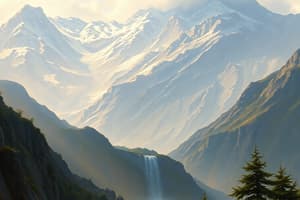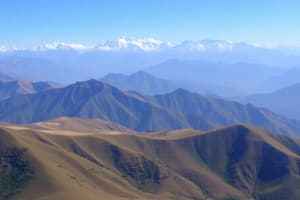Podcast
Questions and Answers
What are the Greater Himalayas also known as?
What are the Greater Himalayas also known as?
- The Himadri (correct)
- The Kullu Valley
- The Lesser Himalayas
- The Himalayas
The Lesser Himalayas are located to the north of the Greater Himalayas.
The Lesser Himalayas are located to the north of the Greater Himalayas.
False (B)
Describe one characteristic of the landscape of the Lesser Himalayas.
Describe one characteristic of the landscape of the Lesser Himalayas.
The landscape includes valleys, plateaus, and rolling hills covered in forests.
The Himalayas acted as a natural barrier against _____ invaders.
The Himalayas acted as a natural barrier against _____ invaders.
Match the following features of the Himalayas with their significance:
Match the following features of the Himalayas with their significance:
Which of the following is the highest peak in the world?
Which of the following is the highest peak in the world?
The Sanskrit word 'Himalaya' translates to 'abode of snow'.
The Sanskrit word 'Himalaya' translates to 'abode of snow'.
What is the main tributary of the Satluj river?
What is the main tributary of the Satluj river?
The Shiwaliks are known for the presence of scenic valleys called _____ .
The Shiwaliks are known for the presence of scenic valleys called _____ .
Which river enters India through Arunachal Pradesh?
Which river enters India through Arunachal Pradesh?
What do you call rivers that arise due to melting snow on mountains?
What do you call rivers that arise due to melting snow on mountains?
Match the following terms with their definitions:
Match the following terms with their definitions:
The Kullu valley and the Lahaul valley lie in the Greater Himalayas.
The Kullu valley and the Lahaul valley lie in the Greater Himalayas.
Flashcards
Mount Everest
Mount Everest
The highest peak in the world, located in the Greater Himalayas range in Nepal.
Himalaya
Himalaya
The Sanskrit word for "abode of snow", referring to the Himalayan mountain range.
Beas River
Beas River
A major tributary that joins the Satluj River. Its source is in the Himalayas.
Duns
Duns
Signup and view all the flashcards
Brahmaputra River
Brahmaputra River
Signup and view all the flashcards
Perennial rivers
Perennial rivers
Signup and view all the flashcards
Distributary
Distributary
Signup and view all the flashcards
Tsangpo
Tsangpo
Signup and view all the flashcards
What are the Greater Himalayas also called?
What are the Greater Himalayas also called?
Signup and view all the flashcards
What are the Lesser Himalayas known for?
What are the Lesser Himalayas known for?
Signup and view all the flashcards
Why are the Himalayas significant in terms of defense?
Why are the Himalayas significant in terms of defense?
Signup and view all the flashcards
What makes the Himalayas important for biodiversity?
What makes the Himalayas important for biodiversity?
Signup and view all the flashcards
Why are the Himalayas important geographically?
Why are the Himalayas important geographically?
Signup and view all the flashcards
Study Notes
Social Studies - Physical Divisions of India
-
Himalayas: A colossal mountain range, divided into three sections:
- Greater Himalayas (Himadri): Home to the world's highest peaks, including Mount Everest and K2; perpetually covered in snow and ice.
- Lesser Himalayas (Himachal): South of the Greater Himalayas, featuring valleys, plateaus, and rolling hills covered in forests; rich biodiversity.
- Lower Himalayas: Lower altitude than the other two; ranging from 600 to 1500 meters above sea level.
-
Himalayan Significance:
- Natural barrier: Prevented unfriendly invasions and attacks.
- Environmental importance: A diverse flora and fauna.
-
Sanskrit word 'Himalaya': "Abode of snow".
-
Main tributary of Satluj: "Beas"
-
Valleys of Shiwaliks: Known for special scenic valleys called "duns".
-
River entering India through Arunachal Pradesh: "Brahmaputra".
-
Largest Plateau in India: "Deccan Plateau" (not Malwa Plateau).
-
Longest Dam in India: "Hirakud Dam" (not Bhakra Nangal Dam). Built over the Mahanadi river, in Odisha.
-
Kullu and Lahaul Valleys: Located in the Himachal range.
-
Deccan Plateau: Largest plateau in India.
Studying That Suits You
Use AI to generate personalized quizzes and flashcards to suit your learning preferences.




